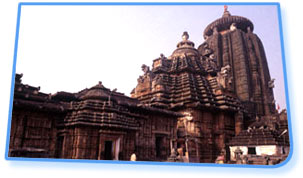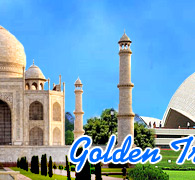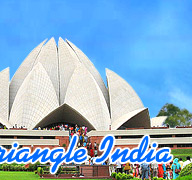Bhubaneswar, Bhubanehswar India, Bhubaneswar Travel, Bhubaneshwar Tours, Tourism in Bhubaneswar, Bhubaneshwar Tour Packages.
Bhubaneshwar India

Bhubaneswar,
popularly known as the 'Temple City of India', is said to be the seat of
Tribhubaneswar or 'Lord Lingaraj' (a form of Lord Shiva). An important
Hindu pilgrimage centre, hundreds of temples have become an integral
part of the landscape of the Old Town, which once boasted of more than
2000 temples. It was here that the temple building activities of Orissan
style bloomed from a mere conception to a full-fledged art over a period
of over one thousand years.
The new Bhubaneswar with its modern buildings and extensive
infrastructure perfectly complements its historic surroundings. The most
important tourist attractions of the city are the temples of
Laxmaneswar, Satrughaneswar and Bharateswar from 6th century,
Parsurameswar and Swarnajaleswar from 7th century, Vaital from 8th
century, Mukteswar from 10th century, Brahmeswar, Rajarani and Lingaraj
from 11th century and Ananta Vasudeva from 13th century. Orissa state
Museum, Tribal Museum & Handicrafts House, Ekamra Kanan, which is
the biggest Rose Garden of Asia, Pathani Samanta Planetarium and BDA
Nicco Park are some other places worth visiting.
| Location: |
In Orissa, India. |
| Significance: |
Capital of Orissa. |
| Climate: |
Situated at an altitude of 45 m above sea level,
the temperature ranges between a minimum of 15.7oC in winters
to a maximum of 30oC to 40oC in summers. |
Shopping Attractions:
Shopping at Bhubaneshwar is fun with so many specialties to choose
from. Silver filigree, stone and woodcarving, Patta paintings, tie &
dye textiles are not the only highlights of its market. One can look for
some good bamboo baskets, brass and bell metal work, horn work and many
other famous handicrafts of Orissa to buy as souvenirs.
Prime Attractions:
Parashurameshwara Temple:
The Parasurameswara is the earliest temple still standing in
Bhubaneswar. The mid-seventh century date agreed on by most scholars is
based on style, as well as on the eight planets, which appear over the
door to the inner sanctum. In later temples, there are nine. Although
the Parasurameswara temple was repaired in 1903, with some ensuing
changes in the roof of the inner sanctum, the structure is substantially
intact in its original form.
This small temple shows the early stages of development of the two main
Orissan temple components: the beehive-shaped tower (generally referred
to as the deul) and the porch in front of the tower (generally called
the Jagamohan). The tower is built in successive, inward-tapering
stories, marked by lotiform corner pieces.
Vaital Deul:
The Parasurameswara and Mukteswara temples represent clear steps in the
development of the major Kalinga style of Orissan temple architecture.
The Vaital Deul (800 AD) represents an entirely different line. It
belongs to the Khakhara order (a subdivision of the Kalinga school of
architecture), which was used for shrines devoted to tantric cults. The
deal (tower) of the temple is the most striking difference. It is
rectangular in shape, positioned at a right angle to the Jagmohana
(porch). The roof vault is derived from earlier freestanding buildings
made of wood and thatch.
The horseshoe-shape of the chaitya arch became an enduring motif,
turning up not only in actual structures, such as the Vaital Deul, but
frequently in sculptural decoration. On the Vaital Deul, the outer
surface of the vault is absolutely plain, in contrast with the heavy
sculptural embellishment of every other existing Orissan temple tower.
The shape of the more common deal form has not been ignored, however; it
has been carefully inserted, in miniature form, on the four corners of
the Vaital Deul's jagmohana (porch). A brief look at the Vaital Deul
shows an extremely accomplished style of sculptural decoration.
Mukteshwar Temple:
Built in the year of 950 AD, the temple is dedicated to Lord Shiva,
Mukteswara, is carved with figures of ascetics in several poses of
meditation. The highlight of the temple is the magnificent torana - the
decorative gateway, an arched masterpiece, reminiscent of Buddhist
influence in Orissa.
Rajarani Temple:
It was built in 11th century. Rajarani temple is famous for its ornate
deul, or compass, decorated with some of the most impressive Oriya
temple architecture. The temple is remarkable for the absence of any
presiding deity. The temple's name is supposed to be derived from the
red-gold sandstone used in building it - Rajarani being the local name
for the stone.
The deul is intricately carved with figures involved in daily chores.
Statues of eight Dipalakas, guarding the eight cardinal directions of
the temple, populate the lower portion of the deul. Between them,
nymphs, embracing couples, elephants and lions fill the niches and
decorate the pillars. Set in a picturesque locale, the temple creates a
dramatic image against the setting sun.
Brahmeswara Temple:
Brahmeswara Temple built in 1050 AD, is situated around a kilometer
east of the main road. The temple stands in a courtyard bordered by four
smaller temples.
Lingaraja Temple:
Built in the 10th or 11th century, Lingaraja temple of Bhubaneswar has
been described as 'the truest fusion of dream and reality. A rare
masterpiece, Ferguson, the noted art critic and historian, has rated the
Lingaraja temple as one of the finest examples of purest Hindu temple in
India. Every inch of the surface of the 55-m-high Lingaraja temple is
covered with intricate and elaborate carvings. Sculpture and
architecture fuse elegantly to create a perfect harmony. It is believed
that pilgrims, who wish to go to the Jagannath temple at Puri, must
first offer worship at the Lingaraja temple.
Orissa State Museum:
The Orissa State Museum is one of the best places to view sculptures,
stone inscriptions, lithic and bronze-age tools, rare copper plates,
palm-leaf manuscripts, paintings, anthropological specimens and musical
instruments.
Handicrafts Museum:
The Handicrafts Museum at Secretariat Road has a good collection of
folk paintings, horn toys, brass castings, and sculptures.
Tribal Museum:
The Tribal Museum deals with the various aspects of the tribal life and
culture in Orissa.
How To Reach
| By Air: |
There are domestic flights to and
from Bombay, Calcutta, Delhi, Hyderabad, Nagpur, Varanasi, Raipur
and Visakhapatnam. |
| By Train: |
Bhubaneshwar is directly connected by trains to
and from Calcutta, Puri, Madras, Delhi, Bombay, Bangalore, Guwahati,
Hyderabad, Tirupati and Trivandrum. |
| By Road: |
Bhubaneshwar is well connected by the National
Highway No. 5 to Calcutta and Madras and other major cities of
India. |
 Bhubaneswar,
popularly known as the 'Temple City of India', is said to be the seat of
Tribhubaneswar or 'Lord Lingaraj' (a form of Lord Shiva). An important
Hindu pilgrimage centre, hundreds of temples have become an integral
part of the landscape of the Old Town, which once boasted of more than
2000 temples. It was here that the temple building activities of Orissan
style bloomed from a mere conception to a full-fledged art over a period
of over one thousand years.
Bhubaneswar,
popularly known as the 'Temple City of India', is said to be the seat of
Tribhubaneswar or 'Lord Lingaraj' (a form of Lord Shiva). An important
Hindu pilgrimage centre, hundreds of temples have become an integral
part of the landscape of the Old Town, which once boasted of more than
2000 temples. It was here that the temple building activities of Orissan
style bloomed from a mere conception to a full-fledged art over a period
of over one thousand years. 











